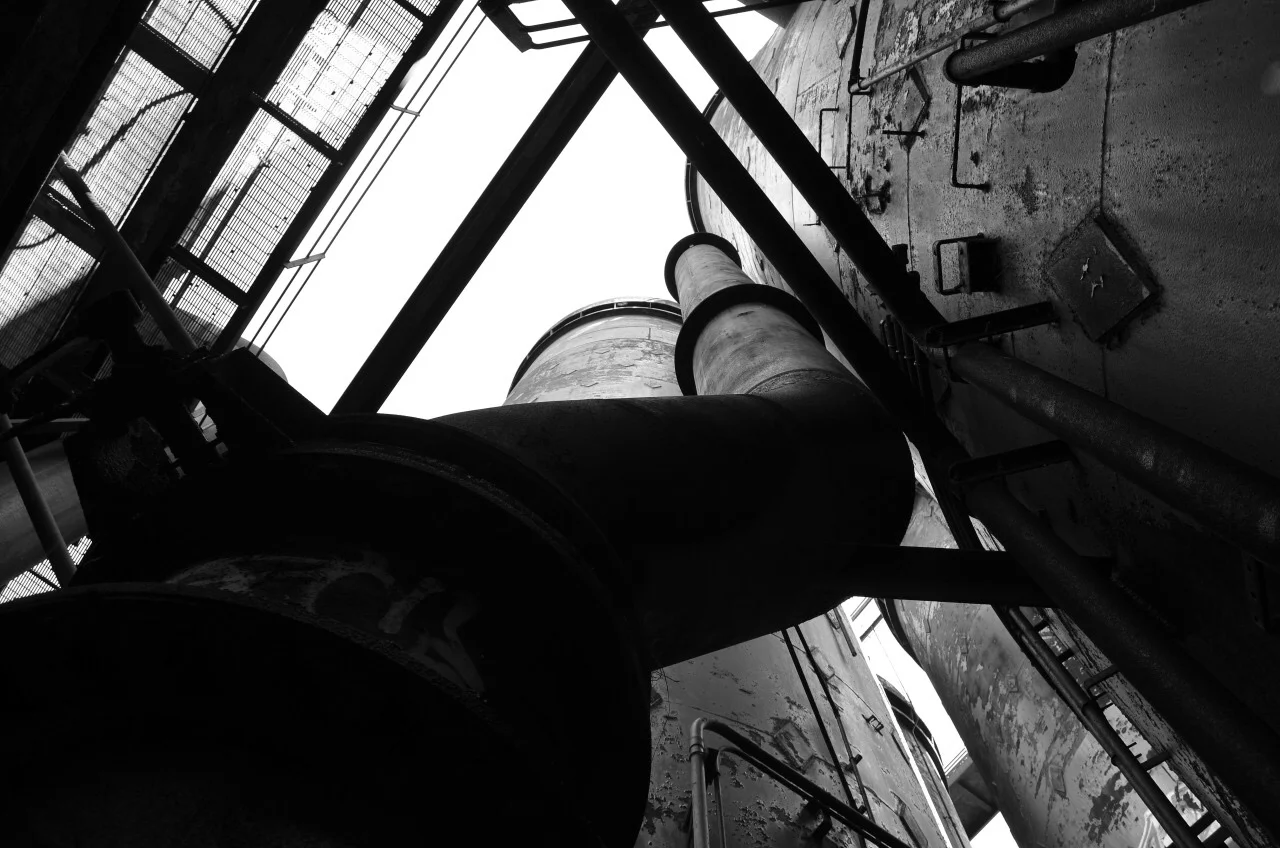Youngstown, O. - A ladle ready to ship out from the William B. Pollock Co. in the 1970s, destined for the Youngstown Sheet & Tube Co.'s Indiana Harbor works. Although Pollock and Sheet & Tube are out of business, the Indiana Harbor mill still makes steel, operated by Arcelor Mittal.
Youngstown Car Manufacturing Co.
Youngstown, O. - This is a company you don't hear much about. Youngstown Car Mfg Co. manufactured the carts shown in this advertisement. With the amount of money run of the mill industrial carts go for today you would be sitting on a fortune if you had one of these to sell. I'd buy it.
Below is a photo of their plant on Wilson Avenue, with Republic Steel's number 2, 3, and 4 blast furnaces in the background. This was part of the William Pollock Co. collection on Ohio Memory, so I assume they built the furnaces. The Youngstown Car Manufacturing Co. plant still stands today, and is now used by Industrial Mill Maintenance.
I was working for an HVAC company in the early 2000s, and was on the roof of the church that sits across the street. I forget the name of the church but it was between Gladstone and Jackson Street . The maintenance man was telling me he went to school there as a kid, and remembered not being able to see across to Poland Ave. because of all the smoke from Republic. I remember trying to imagine what that scene looked like. Imagine no more, this would have been the exact same view I saw 80 years later when the furnaces were gone.
The William B. Pollock Co.
Youngstown, O. - This image from the early 1900s shows an employee of the William B. Pollock Co. posing with a new hot metal handling rail car that looks ready to ship. These cars were designed/engineered/built in Youngstown. Hopefully the man next to the car gives you an idea of the scale, and the amount of molten iron each of these cars moved around the mills.
Image courtesy of Ohio History Connection
The William B. Pollock Co.
Youngstown, O. - Two photos, dated 1910, detailing construction of hot metal cars at the William Pollock Co.; and some of the employees of this company that closed in 1983.
Image courtesy of ohiomemory.org
Image courtesy of ohiomemory.org
US Steel Ohio Works
Youngstown, O. Installation of a goggle valve (fabricated by the William Pollock Co., of Youngstown, O.) at the US Steel Ohio works in the 1940s.
Goggle valve info:
In a blast furnace there is a need to control flows of high temperature and dirty, dust-laden gases. A goggle valve is a type of large industrial valve designed for this type of use. They are another signature item on a blast furnace.
Goggle valves earned their name because the valve plate has two equal circular areas each defined by a sealing ring on both faces of the plate. One circular area is solid and the other is completely open. These two adjacent circular areas resemble a giant pair of eye-goggles. When the solid area is across the valve passage, it blocks the flow of fluid through the valve, and when the open area is across the valve passage, fluid flows freely through the valve. There is no intermediate position. It is either open or closed.
To actuate the goggle valve is a two-step operation. First, a section of the valve body moves in an axial direction to unclamp the goggle plate. This movement is quite small, on the order of a fraction of an inch or so, just enough clearance to allow the goggle plate to move in its housing. Then the goggle plate moves. In older designs it rotates on an arc. That is the type modeled in this kit. The valves body then moves axially back to clamp the valve and seal the perimeter of the openings.
On blast furnaces the valve body is usually exposed to the atmosphere, since small leaks during opening and closing are generally not a problem. This makes the mechanism highly visible. However, in chemical plants, goggle valves are encased in a bonnet to capture any leakage during the actuation.
Goggle valves have two main advantages. First they tend to be compact and can fit in tight confines, though on a blast furnace this is not normally an issue. Secondly, when open, the valve presents a smooth surface to the gas flow. Other valve designs, such as a gate valve, tend to have a valve seat. In a high volume flow with hot dirty gases, the valve seat can cause cavitation, a kind of a bubbling turbulence, which wears away the valve seat and requires expensive maintenance. On the other hand, goggle valves tend to be more expensive to initially install than other types.
WILLIAM B. POLLOCK, Co.
Youngstown, O. - "The End of a Long and Proud History" This is a sad one. This company built blast furnaces and hot metal transportation equipment that was not only used in the Steel Valley, but all over the world. They lasted 120 years. The tombstone in the bottom right of the photo reads "Pollock Company 1863 - 1983 Laid to Rest by GATX" Present in this photo: Front, left to right: Barry Shultz, Bill Kasmer, Tom Hull, Jim Roper, Emily, Joan, Ray, Bob, Bill Hill, John Titak, Bill Deak, Jim Slifka, Mike Kohl, unknown, and Joe Bunosky. To right side of grave marker: Sam Muscatell, unknown, and Dwayne Schonce. Back row: Laddie Bodnor, Roger Powell, and Chester Queen. Images courtesy of Ohio History Connection.
The Final Shipment
Here are some images of employees dating back to the early days of the company
1910 - Cinder Car
1910 - Fabrication Crew - Could be building Cowper stoves for a blast furnace.
1910 - Showing off new safety goggles.
1940s/50s - Line of Pollock Co. cinder cars with US Steel's Edgar Thompson works in the background.
1960 - Pollock hot metal car at J&L steel Pittsburgh works.

